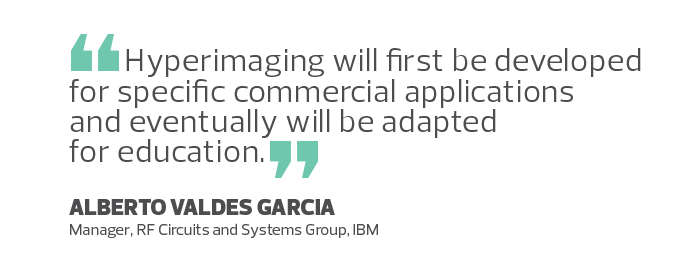Why Hyperimaging May Be the Next Big Thing for K–12 Schools
Sometime in the not-so-distant future, researchers predict people will be able to see easily through opaque objects and visualize what’s invisible to the naked eye — and they won’t need a bulky and expensive machine to do it.
Called hyperimaging, or multispectral imaging, this technology taps into portions of the electromagnetic spectrum that humans can’t see, like radio waves, millimeter waves, microwaves and X-rays. Humans cannot see 99.9 percent of waves on the spectrum, but Alberto Valdes Garcia, research staff member and manager of the RF Circuits and Systems group at IBM, is working on harnessing this technology to help people see like a superhero.
“Hyperimaging will first be developed for specific commercial applications and eventually will be adapted for education,” Valdes Garcia says.
SIGN UP: Get more news from the EdTech newsletter in your inbox every two weeks!
Hyperimaging and AI Make Sense of Complexities
For more than 100 years, researchers have relied on technology to see the unseen, using tools like X-ray machines, magnetic resonance imaging and high-end telescopes to peer inside the brain or detect objects light-years away in the universe. Right now, these technologies are specialized and costly. For example, separate machines are required for detecting X-rays and infrared rays.
The hyperimaging technologies currently under development will emit and detect many separate portions of the electromagnetic spectrum. High-performance, compact sensors will aim a beam of millimeter wave energy toward an object to capture data about its distance, location and reflectivity.

Artificial intelligence will process this information to make sense of the object, its properties or its surroundings. This could help researchers discover more about existing objects or provide advance warning about hidden dangers.
Valdes Garcia predicts that within five years, hyperimaging will be integrated into portable devices that could change the world. For example, millimeter wave imaging combined with AI embedded in a vehicle could help drivers or self-driving cars navigate through bad weather conditions such as fog or rain, or even detect oncoming road hazards like potholes or black ice.
Future Tech Creates a New Way of Seeing in Schools
While these futuristic technologies won’t be in schools any time soon, educators can start to think now about how they might be used.
“In high school, students are already creating apps for Raspberry Pi microprocessor control units to build robots that navigate via camera,” Valdes Garcia says. “Hyperimaging technology could easily be integrated into these projects to add to the robot’s capabilities.”

Samantha Becker, senior director of publications and communications at the New Media Consortium, sees hyperimaging as a disruptor like virtual reality, AI and the Internet of Things when applied to teaching and learning.
“When students work with certain objects or substances in science labs, this technology could provide hidden information,” Becker says. “That could lead to insights, such as how long a substance has been left out, if it’s starting to spoil or what chemicals it contains.”
“As with VR, AI and IoT,” Becker continues, “the value is in making the invisible more discoverable, which provides learners with new experiences and new ways to engage with the world around them.”








